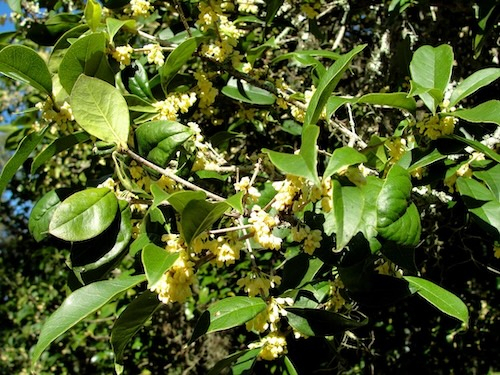
Sweet olive blossoms are tiny but powerfully fragrant.
October 2, 2025 - I don’t see them regularly, but I often smell them. The flowers of the sweet olive (Osmanthus fragrans), which appear in fall, early spring, and even during mild winters, are small and creamy white, but their fragrance is among the most powerful and distinctive of any garden plant. It also happens to be one of my all-time favorite garden scents. Originally from China, sweet olives have been cultivated in temple and home gardens there for so long that their exact origins are uncertain. Following the usual route west, they were brought to England in 1771 and soon after to America.
Sweet olives form a shrub or small tree that can reach fifteen feet or more in older gardens of the Deep South. Their evergreen foliage and dense form make them valuable as specimens, hedges, or masses in the landscape. Sweet olives prefer moist, deep, acidic soils, though they adapt fairly well to less favorable conditions. A rarer orange-flowering form, known as variety aurantiacus, occasionally shows up in Southern gardens, but it blooms only once per year.
Historical records give us a glimpse of their presence in American gardens. At Rosedown Plantation in St. Francisville, Louisiana, Martha Turnbull purchased three “Chinese fragrant olives (used to scent their tea)” from the New York nursery William Prince and Son in 1836. Today, the massive descendants of those plants perfume the entire garden during fall and spring. Appropriately, giant sweet olives also grace the Grace Episcopal Cemetery in St. Francisville, where she is buried.
Although they are not true olives, sweet olives belong to the olive family and are related to ash, forsythia, ligustrum, lilacs, and jasmine. The disastrous freeze of 2021 damaged many in East Texas, freezing some to the ground, but most survived and have since recovered. Other than occasional cold injury, sweet olives are rarely bothered by insects or diseases, making them remarkably dependable plants for East Texas gardens.
My friend and former boss, Dr. Dave Creech, director of SFA Gardens in Nacogdoches, notes that over ten Chinese cities honor the sweet olive with special festivals each October when the plants bloom in profusion. It is considered one of the ten traditional flowers of China. The most ancient known specimen still thrives on the grounds of the Shengshui Temple in Shaanxi Province and is over 2,100 years old.
It is no wonder that this plant has been treasured across continents and centuries. When in bloom, its fragrance can drift across the entire landscape, turning an ordinary stroll into a sensory experience. Sweet olives may not be flashy in appearance, but their scent earns them a place among the most cherished of Southern garden plants.









